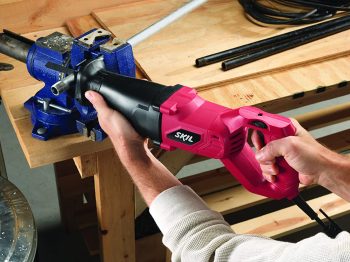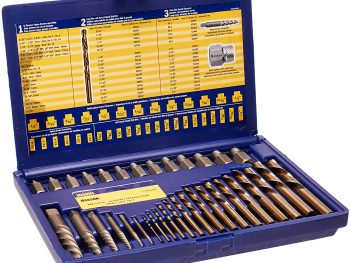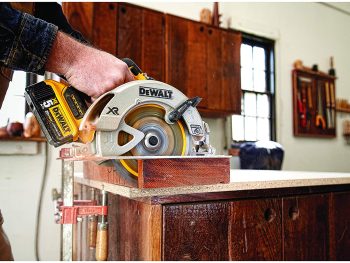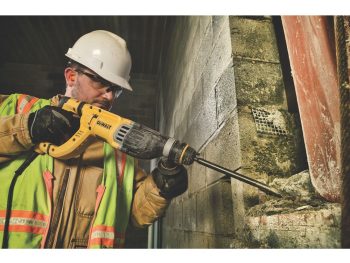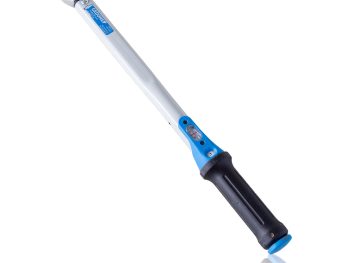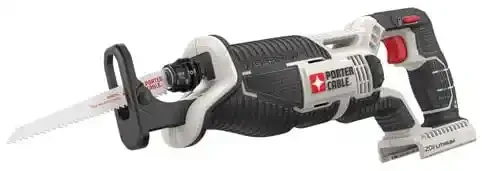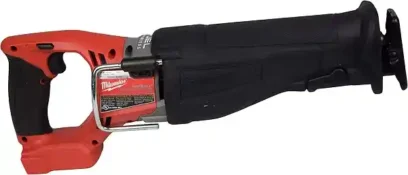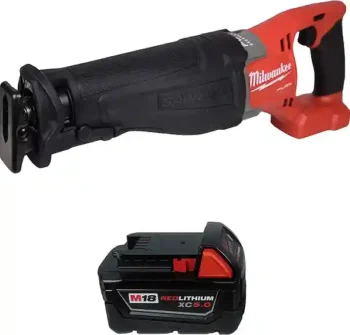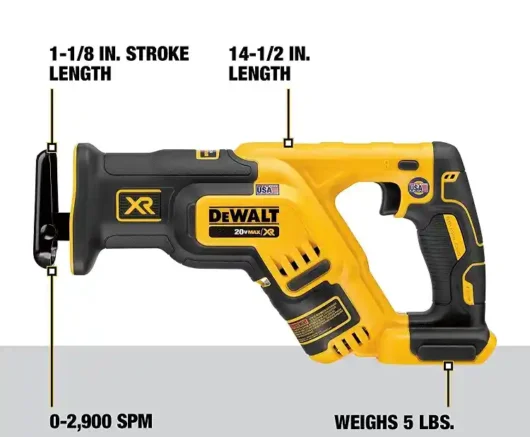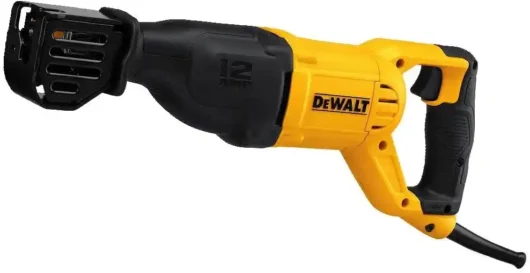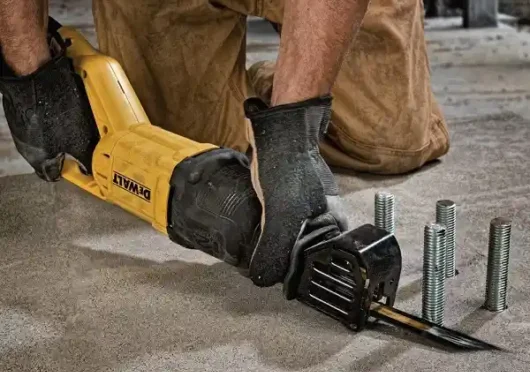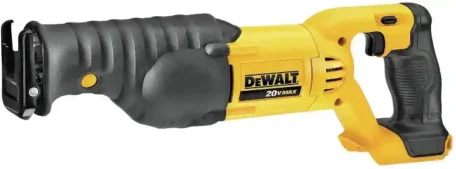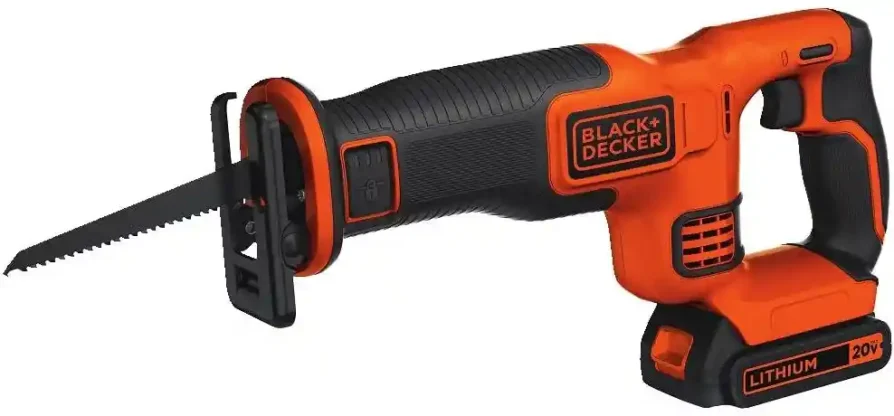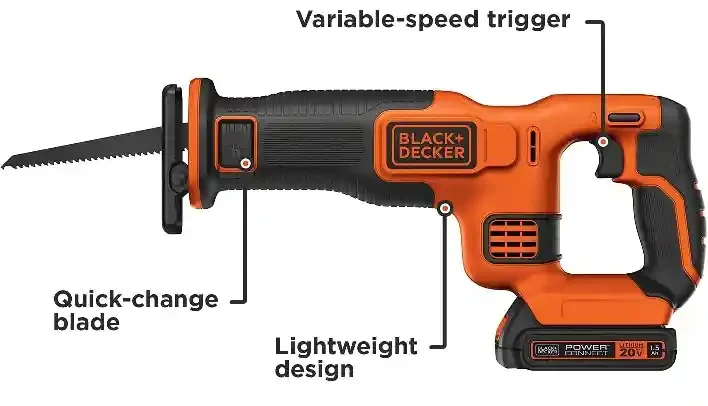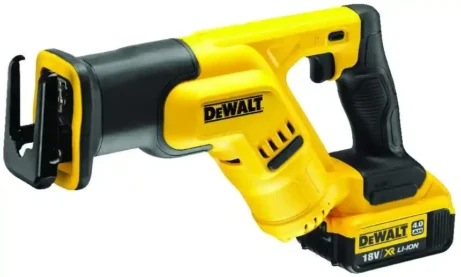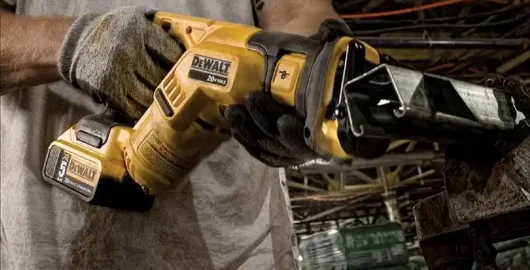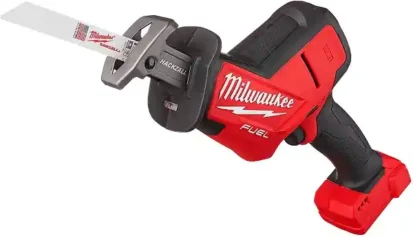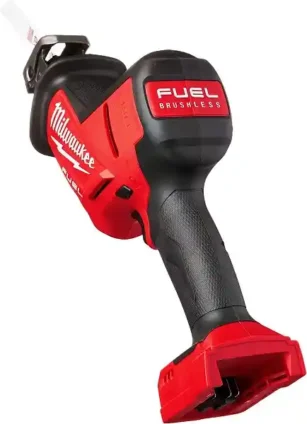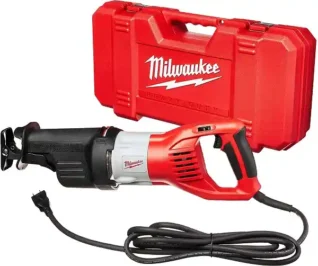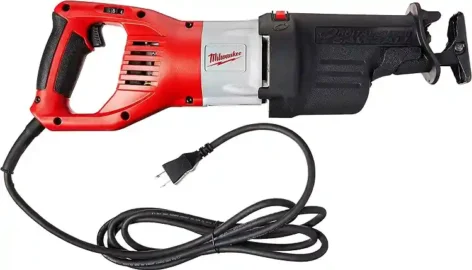Best Reciprocating Saw - Top 10 Rankings & Application Based Picks
Affiliate disclosure: Handy Tool Adviser is reader supported. When you buy through our links, we receive a small commission at no additional cost to you.
Last updated: 20-December-2025
Are you wondering what is the best reciprocating saw in the market? Have you checked different options available and have tried comparing their specifications and features but can’t make the final decision? With so many options and competing brands, it becomes hard to choose the best option for your requirement.
In this post, we will give you our top 10 recommendations on the best reciprocating saws we found in our market survey and guide you about their pros, cons and specialties to help you make the right decision.
Our recommendations are for light to medium duty jobs that include cutting through metal pipes, PVC pipes, HVAC tubing, nail embedded wood, plywood, light to heavy gauge metals, drywall, plaster, plastics, rubber, sheet metal, fiberglass, composite materials and pruning.
Ranking the Top 10 Best Reciprocating Saws
Our top ten list and ratings for the best reciprocating saw is based on a combination of parameters including power, performance, compactness, safety features, ergonomic features, manufacturer’s support and variety in applications. So without further due, let’s begin.
10
Skil 9206-02 Corded Reciprocating Saw
Best on a Budget | Under $50 | Great for Occasional Use
Our Rating: 8.7 / 10
Skil 9206-02 reciprocating saw is a corded model with 1-1/8” stroke length and 2700 strokes per minute powered by a 7.5 amp conventional motor that allows it to cut through metal jobs as easily as it cuts through wood.
It has a keyless blade clamp that can accommodate the cutting blade in two positions (upwards & downwards) - a nifty feature to save your time in complex scenarios.
Fitted with the correct metal cutting blade, this reciprocating saw can cut through a hottub in your bathroom or a cast iron pipe in your backyard. Take it out in the garden (with an extension cord) and it can cut through saplings of maple, oak and even ironwood after a challenge.
However, we wouldn't recommend it for the daily grind. This model gives decent cutting performance on wood and metal for occasional users at an economic price point of under $50 (at the time of this review).
Skil doesn’t give a rafter hook/belt clip or case for storage of the tool, however, these are not standard accessories in competitor products as well.
Pros
Compromises
9
PORTER-CABLE PCC670B Cordless Reciprocating Saw
Best Cordless Reciprocating Saw on a Budget | Best for Pruning
Our Rating: 9.0 / 10
This cordless reciprocating saw gives good cutting performance with a stroke length of 1” and 3000 strokes per minute powered by a conventional brushed motor controlled by a variable speed trigger.
It has a keyless blade clamp that can accommodate the cutting blade in two positions (upwards & downwards) just like the SKIL model above.
It is well suited for pruning owing to its compact and lightweight design that makes it easy to carry around as well as being a cordless model so your radius of work is not limited by a power socket - something very useful when you are out on the field.
To give an idea of its utility, it can cut through tree branches (up to 6 inches in diameter) easily for making logs for fireplace. It can be used for repairing your fence, disassembling a dog house, getting rid of a fallen pine tree (around 6” trunk) and helping through plumbing jobs of cutting through PVC and cast iron pipes (with proper metal blades). However, it lacks power to cut through thicker gauge metals.
It would have been a joy to have rafter hook/belt clip, battery with charger, general purpose blade and a case or bag for tool storage in the same package, however, there isn't much to be complained about at a price of under $60 (at the time of this review).
Pros
Compromises
8
Milwaukee 2720-20 M18 Fuel Sawzall
Our Rating: 9.1 / 10
This Milwaukee Sawzall M18 is a powerful cordless (battery operated) reciprocating saw with stroke length of 1-1/8 inch and 3000 strokes per minute controlled by a variable speed trigger.
It has a keyless blade clamp that can accommodates the cutting blade in two positions (upwards & downwards) just like the SKIL and Porter-Cable models above. It has good metal cutting ability when used with the right blade.
In order to prolong the life of the tool, it comes with an electronic control system named "REDLINK PLUS Intelligence system" to protect the reciprocating saw from overload, overheating and over-discharge - a feature that will cover for occasional carelessness every one of us shows now and then.
One important observation that has caused this model to rank lower in our list is the lack of durability in its blade changing mechanism that can compromise blade fixation over consistent use in medium to heavy duty applications. The mechanism lacks on robustness.
This particular package does not come with a case/bag for tool storage; a battery with charger and a general-purpose cutting blade but we can’t hold it against Milwaukee because majority of the manufacturers out there are not giving these accessories.
Pros
Compromises
7
DEWALT Cordless Reciprocating Saw (Model DCS367B)
Best for Home Construction Projects
Our Rating: 9.2 / 10
DEWALT Sawzall makes its place in our list with a stroke length of 1-1/8 inch and 2900 strokes per minute controlled by a variable speed trigger and powered by a battery.
When it comes to an all rounder performance in cutting 2x4s, plywood and nail embedded wood, it beats competition - something you may not expect from a cordless model.
It will cut cement boards, fire woods, manzanita and other tree stumps and roots without a problem. It is also a good supporting tool for demolition jobs. It makes it a great choice for home construction.
However, it has not been ranked higher on our list because it has shown considerable negative feedback on vibration control that makes it unfit for long duration use.
It would’ve been a plus if DEWALT had given any of the rafter hook/belt clip, battery/charger, general purpose blade or a case/bag for storage of the tool, but you would have to buy them separately.
Pros
Compromises
6
DEWALT Reciprocating Saw (Model DWE305)
Best for Cutting Light to Medium Gauge Steel & Iron
Our Rating: 9.3 / 10
This corded DEWALT Sawzall comes with a stroke length of 1-1/8” and 2900 strokes per minute powered by a 12 amp conventional motor and controlled by a variable speed trigger.
As you would expect from a corded model, it has returned one of the highest customer feedbacks in competition in cutting steel, iron and metallic jobs with small number of vibration complaints. It carries that typical heavy duty appeal in its build size and weight that translates into tough performance as well.
To give a few examples of its utility, you can use it for your home renovation projects like remodelling your pantry or constructing a closet and anchoring hanger rods after cutting through drywall with this tool. You can use it for clearing your yard of the elm, aspen, birch and scotch pine sprout saplings. After fitting a correct metal blade, you can easily cut through a 4 inch cast iron pipe to fix a drain line or a ¼ inch angle iron to make a frame.
It has been placed below the Dewalt DCS380B (next on our list) because of its limitation with respect to portability (being a corded model).
As usual for most brands, rafter hook/belt clip, general purpose blade and a case/bag for storage of the tool are not included in this particular package.
Pros
Compromises
5
DEWALT Cordless Reciprocating Saw (Model DCS380B)
Our Rating: 9.4 / 10
This cordless DEWALT reciprocating saw comes with a stroke length of 1-1/8” and 3000 strokes per minute powered by a conventional motor and controlled by a variable speed trigger.
Its 4-position blade clamp gives it an edge over majority competitors especially in the area of flush cutting because you can also install its blade sideways to work some difficult cutting angles.
To give an idea of its utility, you can use it from cutting through suspension bolts in your automobile workshop to pruning an apple tree. It can be used in your kitchen remodelling project to cut through cabinets as easily as it would cut through the sink piping. However, there have been complaints about its energy efficiency that it drains battery fast.
We would’ve given it a higher rating if DEWALT had given rafter hook/belt clip, battery & charger, general purpose blade and a case/bag for storage of the tool.
Pros
Compromises
4
Black+Decker Cordless Reciprocating Saw
(Model BDCR20C)
Economical Price | Best for Home Use & DIY
Our Rating: 9.5 / 10
The Black and Decker reciprocating saw BDCR20C gives a very good cutting performance with 7/8” stroke length and 3000 strokes per minute powered by a conventional motor and controlled by a variable speed trigger. It has keyless 2-way blade clamp similar to other tools.
At a price of around 60 bucks (at the time of this review), it is the best budget reciprocating saw for home use and DIY. It has the best feedback on pruning as compared to competitor tools whereas its performance on metals, PVC and home construction wood is acceptable making it a great all rounder at low price point.
To give an idea of its utility, it can be used for making decorative shutters for windows, upgrading your shed with storage shelves, getting rid of a cast iron clothing post (but with correct metal blades) or pruning pine trees in your yard.
However, this tool is not designed for professional cutting jobs and there have been vibrations complaints during cutting tough materials.
Black and Decker also gives 2 year warranty with the condition that the tool is used in "home environment" - a limitation not imposed by competitors in their tools.
Pros
Compromises
3
DEWALT Cordless Reciprocating Saw (Model DCS387B)
Very Compact Design | Great in Flush Cutting
Our Rating: 9.6 / 10
Featuring a stroke length of 1-1/8” at 2900 strokes per minute powered by a conventional motor and controlled by a variable speed trigger, this Dewalt Sawzall has 4-position blade clamp just like other Dewalt models on our list that gives it an edge over majority competitors especially in the area of flush cutting because you can also install its blade sideways to work some difficult cutting angles.
Its compactness is ahead of competition that allows it to be used in hard to reach areas and confined spaces. It is also a great all rounder with portability and enough cutting power for nail embedded wooden jobs, PVC and metallic pipes. Its utility can range from cutting 6 inch tree limbs to cutting through the windshield seal of a car. It’s a suitable fit for your bathroom, kitchen or general home renovation projects.
However, reports of vibrations have been found causing inconvenience to some users especially on harder jobs therefore it is not fit for professionals who use reciprocating saws for long durations in a go.
Dewalt does not give hook/belt clip, battery & charger, general purpose blade and a case/bag for storage of the tool.
Pros
Compromises
2
Milwaukee M18 FUEL Hackzall (Model 2719-20)
Best Cordless Pick | One Handed Operation | Excellent Portability & Ease of Use
Our Rating: 9.7 / 10
This Milwaukee M18 FUEL Hackzall is our answer for the best cordless reciprocating saw. It is a powerful cordless (battery operated) reciprocating saw with stroke length of 7/8 inch and 3000 strokes per minute controlled by a variable speed trigger. It has a keyless blade clamp that can accommodate the cutting blade in two positions (upwards & downwards).
The specialty of this tool is that its design is optimized for one handed operation for user convenience especially in reaching tricky spots such as overhead jobs, and yet, instead of vibration complaints, customers have praised its minimal vibrations.
To give an idea of its utility, you can use it to cut through nail embedded wood, particle boards and dead 6 inch pine trees. It will cut through the exhaust of your scrap truck and the bell housing of an automatic transmission in your automobile workshop or garage. It will remove old lath from your walls in your home renovation project. It cuts through PVC pipes, cast iron pipes and other tubing easily with good battery timing making it a very handy tool for someone like a union plumber.
Milwaukee has also made rubber seal and weep holes in this machine for added protection against water ingress and debris - a feature that will prolong the life of tool in jobsite environments.
This package does not include rafter hook/belt clip; a case or bag for tool storage and battery with charger with the tool.
Pros
Compromises
1
Milwaukee Super Sawzall (Model 6538-21)
Most Powerful Option | Best for Professionals | Great for Hardcore Jobs
Our Rating: 9.8 / 10
Number one on our list is this powerful corded reciprocating saw from Milwaukee with a 15 amp conventional motor providing 2800 strokes per minute on a stroke length of 1-1/4 inch that can cut through wood and thick metal alike.
It is a professional cutting tool with positive customer feedbacks and praises of having superior power. From cutting apart and scrapping a totalled car to demolition of a pool deck, this machine is built for tough work. Pruning pine trees, removing stumps, roots and saplings, cutting drywall and hardboards, removing kitchen cabinets, cutting through deck joists, fixing your ceiling trap door, cutting sheet metal, steel stanchions and iron water pipes are examples of jobs this tool is built to perform.
Despite high power, it has been reported to have very low vibrations than competition, thanks to its counterbalance mechanism - a feature that makes it suitable for all day long jobsite usage. It makes it the best reciprocating saw for professionals.
Super Sawzall is the right name for this tool as it is indeed super in its performance.
It would have been a plus if Milwaukee gave rafter hook/belt clip and at least one general purpose cutting blade with the tool, however, the storage case is nice.
Pros
Compromises
The Ingenious Engineering of Reciprocating Saws
If you have ever wondered how reciprocating saws actually work, let us give you an insight into its interesting engineering. The real engineering in a reciprocating saw is in converting the rotational motion of a DC motor into reciprocating motion (technically known as rectilinear motion).
What is generally referred as a gearbox in a reciprocating saw is actually the main part that makes the above referred conversion possible. The rotational motion of the DC motor is converted into rectilinear motion by a gear mechanism leading to a wobble plate that in turn connects with the saw blade. It is best explained in the 3D animation below.
We give credit to Animation Xplaned YouTube Channel for the above animation who has done a marvellous job in making the engineering of reciprocating saws so simple to understand.
Buyer's Guide Questions
What is the difference between Sawzall and reciprocating saw?
Reciprocating saw and Sawzall refer to the same power tool. Sawzall is the name used by Milwaukee Electric Tool Corporation, USA for the reciprocating saw it has pioneered since 1951. Since Milwaukee was the pioneer in manufacturing reciprocating saws, their brand name ‘Sawzall’ became synonymous with reciprocating saw and many people start referring to all reciprocating saws as Sawzalls.
The top two positions in our rankings are given to Milwaukee Sawzalls. Milwaukee is still among the best manufacturers of reciprocating saws that they call Sawzalls.
Should I buy a corded or cordless reciprocating saw?
By default you should buy a cordless reciprocating saw and keep multiple batteries with yourself to avoid work stoppage just because of battery backup limitations. Once battery backup is available, you have the freedom to use your tool anywhere and any way you like with zero limitations.
You must go for a corded version if both of the following conditions fit your nature of work,
- You use the tool at places where power sockets are easily available such as DIY workshop and indoor uses only.
- You use the tool for extended periods of time like 8 hours a day.
The best cordless reciprocating saw in our review is Milwaukee 2719-20 M18 FUEL Hackzall and the best corded reciprocating saw in our review is Milwaukee 6538-21 Super Sawzall.
Can I use a reciprocating saw to cut tree branches?
Yes you can. In fact, there are reciprocating saw blades especially designed for this purpose and are called pruning blades. Pruning is one of the most common utilization of reciprocating saws. A cordless reciprocating saw that is compact is best for pruning purposes. We recommend PORTER-CABLE Cordless Reciprocating Saw Model PCC670B for pruning based on its great cutting performance at light weight and low cost.
How thick of a wood can reciprocating saw cut?
It depends on the hardness of wood (based on what type of wood you are cutting) and the length of saw blade you are using with your reciprocating saw.
Saw blades typically range from 3 inches to 12 inches in length, however, 12 inch blades tend to wobble a lot that result in poor cutting performance especially on harder materials. If the wood is soft, you may be able to cut a 10-12 inch thick piece but if the wood is hard, you may not be able to cut more than 6-9 inches of thickness.
If you liked this post, please share it with someone who may benefit from it.
Other articles you may like
